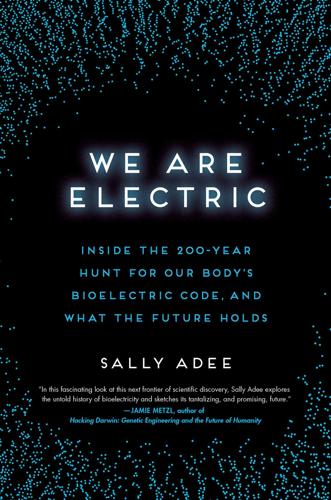
We Are Electric: Inside the 200-Year Hunt for Our Body's Bioelectric Code, and What the Future Holds
by
Sally Adee
Published 27 Feb 2023
He had thoroughly won the day. The battery invalidated Galvani’s claim to the existence of animal electricity—not because Volta had proved it, but because he said so. Apart from a few stubborn Galvani loyalists like Spallanzani, the voltaic pile swung the scientific community to his side. “Thunder of truth” Carradori switched teams one last time to back Volta, along with “ruinous downfall” Brugnatelli.41 With no leader left, the serious study of animal electricity fell away. Neither Galvani nor his supporters had ever been able to measure animal electricity with any kind of electrometer. The current was simply too faint to be detected by the instruments of the day.
…
In 1801, Napoleon’s French Académie launched a commission (the fifth in as many years), offering a prize of 60,000 francs for anyone who could do for animal electricity what Volta had done for the metallic or artificial variety.10 (In today’s money, this would have been worth around £860,000.) Generous as it was, however, the prize went unclaimed. No one was in the position to make something as consequential as a battery for animal electricity. In addition, the false perception that acceptance of metallic contact theory and animal electricity had to be mutually exclusive meant, for many, that because Volta (so heavily favored by Napoleon) had been demonstrably right, Galvani must by definition have been wrong.
…
Unlike the frog battery, this one had been prepared in the style popularized by Galvani many years ago: flayed, head and midsection almost entirely missing save for the two crural nerves that still connected its spine to its legs, which remained whole. When the wire made contact, the hideous little half-puppet immediately jerked into the familiar dance. Animal electricity—and animal electricity alone—had caused a dead frog’s legs to move. Here, forty years after Galvani’s death, was the first real progress in electrophysiology since the days of Galvani himself. Matteucci was another of the promising young scientists who had been mentored and funded by Humboldt during the decades animal electricity fell out of favor. Humboldt had been inspired by Matteucci’s enthusiasm for the promise of an underlying electrical force in the nerves, and had recommended the young scientist for the professorship he now held at the University of Pisa.

The Battery: How Portable Power Sparked a Technological Revolution
by
Henry Schlesinger
Published 16 Mar 2010
With papers endorsing and refuting the two differing theories circulating between supporters of both sides, Galvani in some of his last writings proffered the idea of two different types of electricity—animal electricity and common electricity. Not quite a complete concession, the good doctor’s suggestion was closer to a compromise based on diplomacy and perhaps weariness with the debate rather than experiment or scientific fact. Volta, still working hard to prove his bimetallic theory, offered up his own compromise. He would admit that animal electricity exists, but not in the way that Galvani described—accumulating in muscles, particularly in severed limbs and small pieces of muscle.
…
Napoleon’s well-publicized interest in science seemed to have a somewhat calming effect on the ruling class, and in 1810, Napoleon made Volta a count. Volta’s public demonstrations, including an engagement at the Royal Society, focused on the battery’s design and function rather than theory and touched only lightly on the controversy over animal electricity that had lasted eight years. Volta carried with him a small, pocket-sized battery as well, showing how the device could be scaled down for portability—though its diminutive size proved less impressive than the larger pile or crown of cups. Soon, other natural philosophers began giving their own demonstrations of the device.
…
Patents for electrical devices, of course, were difficult. It was necessary to show a useful application, and the few that did receive patents at the time often listed medical purposes. NOT SURPRISINGLY, WITH A DEVICE capable of producing a continuous flow of electrical current, the debate surrounding animal electricity was soon forgotten. Unlike a Leyden jar, which required constant laborious charging and from which electricity exploded in an electrostatic burst, the battery was easily constructed out of readily available materials and provided a relatively long-lasting and steady flow of current with which to experiment.

Energy: A Human History
by
Richard Rhodes
Published 28 May 2018
Trying to reproduce one of Galvani’s experiments—connecting the back and leg of a living frog with a metal conductor—he had found that he needed two different metals in contact with each other (“a key, a coin . . . but of an entirely different metal from tin or lead”8) to make the frog’s leg contract. He pondered a variety of explanations, struggling with the accepted belief that animals generate a special kind of electric charge in their muscles and transmit it through their nerves. This “animal electricity” was believed to be different from static electricity or lightning and unique to each animal. Galvani believed his experiments had elicited animal electricity rather than ordinary, non-vital electricity. Volta doubted Galvani’s claim: If so, why did a living animal’s leg respond only when he linked spine to muscle with a bimetallic conductor? Why not a conductor made of only one metal as well?
…
Volta suspected that the electric charge demonstrated by the frog’s response came not from the frog but from the contact between the two dissimilar metals—a conclusion that offered an exception to the animal electricity theory and thus challenged its validity. To confirm his suspicion, Volta tried another experiment. He prepared a frog leg with a long piece of nerve extending out of the thigh. To the bare nerve, but not touching the thigh, he then clipped two leads from a weakly charged Leyden jar. The leg muscles contracted. The current from the Leyden jar had stimulated the leg muscles even though it had circuited only through the nerve. To Volta, that meant the current didn’t originate in the muscle, as the animal-electricity theory proposed. Volta then administered his coup de grâce: he prepared another frog leg with a similarly exposed crural nerve, but instead of connecting the nerve to a Leyden jar, he clipped on an arc of two dissimilar metal strips, one of tin leaf and the other of brass.
…
“Instantly the entire limb will be excited into convulsions and kicks,” he wrote, “yet the limb has not been touched, and it is inconceivable that it could be reached by the electrical fluid, which has traveled only between . . . two adjacent parts of the nerve.”9 If he could make the frog leg jump by attaching a bimetallic conductor, Volta concluded, “then there is surely no reason to assume that a natural, organic electricity is at work here.”10 Volta’s “nerve only” experiment: (a) with Leyden jar, (b) with bimetallic conductor. Volta was generous enough, or sensitive enough to the politics of science, not to try to crush Galvani entirely. He praised him instead with a qualified superlative: “Galvani’s great discovery of a full-fledged animal electricity,” he announced, “remains solid and stable; nonetheless, it must be limited to fewer phenomena, and nearly all his suppositions and explanations collapse.”11 Volta went on to prove that no animal tissue need be part of the apparatus to make electricity. Years intervened between Galvani’s 1792 report and Volta’s ultimate response, years of debate across scientific Europe and of further experiments and reports.

Life Is Simple: How Occam's Razor Set Science Free and Shapes the Universe
by
Johnjoe McFadden
Published 27 Sep 2021
For Turner, this did not make life any less magical because he believed electricity was a form of magic, but it did suggest that animal magic might also be captured in a Leiden jar. Colonel John Walsh (1726–95), an English soldier, scientist and diplomat posted to India, performed a more extensive study of animal electricity, as it came to be known. After being elected a member of the Royal Society in 1772, he was introduced to Benjamin Franklin and the two men came up with a plan which Franklin wrote up as ‘Direction to Discover whether the Power that gives the Shock in touching the Torpedo… is Electrical or Not’.
…
A public demonstration of his experiments, with perhaps a nod to Abbé Nollet, demonstrated that the torpedo shock, like Leiden jar electricity, could be passed along a human chain. He wrote to Franklin reporting that ‘The Effect of the Torpedo appears to be absolutely Electrical’ and an example of animal electricity. Walsh’s experiments had pretty much proved that the torpedo’s shock was a form of electricity, but could electricity play a more fundamental role as the vital force that animated all living things, as Robert Turner had proposed? At 8.30 p.m. on the evening of 26 April 1786, Luigi Galvani (1737–98), an anatomist and physician from the University of Bologna, went into the garden of the Palazzo Poggi carrying a collection of dissected frogs’ legs and spinal cords attached to brass hooks.
…
More interestingly, Humboldt discovered that the fish were able to control and direct their shock. For example, when one of the pair held the animal’s head and the other its tail, only one of them usually received a shock, which could be delivered at either end. These experiments convinced Humboldt that animal electricity was essentially the same as ‘the electrical current of a conductor charged by a Leyden vial, or Volta’s pile’ but one that the animal could control. Humboldt spent four more years travelling in Latin America culminating in his legendary ascent up the mighty Chimborazo mountaini in the Andes where he and Bonpland conducted the first-ever systematic bio-geography study, documenting the mountain’s plant life from the tropical rainforests at its base to the lichens clinging to its rocky pinnacle.

The Age of Wonder
by
Richard Holmes
Published 15 Jan 2008
If the Life Force was ‘super-added’, some power outside man must obviously have added it.8 In drawing his analogies between Vitality and electricity, Abernethy also called on the authority of Humphry Davy’s Bakerian Lectures at the Royal Society. Like many scientific men of the day he was entranced by the potentialities of the voltaic battery, and its possible connections with ‘animal magnetism’ and human animation. Electricity in a sense became a metaphor for life itself. ‘The experiments of Sir Humphry Davy seem to me to form an important link in the connexion of our knowledge of dead and living matter. He has solved the great and long hidden mystery of chemical attraction, by showing that it depends upon the electric properties which the atoms of different species of matter possess…Sir Humphry Davy’s experiments also lead us to believe, that it is electricity, extricated and accumulated in ways not clearly understood, which causes those sudden and powerful motions in masses of inert matter, which we occasionally witness with wonder and dismay.’9 The lectures excited great interest in the medical profession, but not yet among the general public.
…
The art of living happy is, I believe, the art of being agreeably deluded; and faith in all things is superior to Reason, which, after all, is but a dead weight in advanced life, though as the pendulum to the clock in youth.’106 In July he went down to the coast to collect some specimens of the electrical eel or torpedo fish at Trieste. He had renewed his interest in Vitalism and the mysteries of animal electricity. But he hurried back to Laibach, again writing to Jane almost teasingly: ‘I am just returned to my old quarters & my pretty Illyrian nurse, after an excursion of a fortnight to Trieste…I succeeded in my projected experiment on the Torpedo and I have I think been able to establish a new principle with respect to the species of Electricity which will be a [gain] in Nat Science.’107 He worked on throughout the summer, trying to believe he was convalescing, and remained at Laibach as long as possible, until the autumn weather broke and the snowclouds began to gather in the mountains.
…
It was published on 20 November 1828. He had now submitted forty-six papers to the Society, his first on the voltaic battery long ago in June 1801, and his most famous one on the safety lamp in 1816. He did not want the torpedo to be his last, and he continued to investigate the mystery of ‘animal electricity’ and its possible connection with the universal principle of life. John Herschel would be particularly struck by this paper, which compared the electric eel to a voltaic battery, asked whether the eel could exert this ‘most wonderful power’ at will, and speculated whether the human brain itself might be ‘an electric pile, constantly in action’.144 Nature held other analogies, too.

How We Got Here: A Slightly Irreverent History of Technology and Markets
by
Andy Kessler
Published 13 Jun 2005
In 1780, Italian Luigi Galvani and his assistant were dissecting frogs, and the assistant dropped a metal scalpel on a frog’s leg (yes, apparently they tasted like chicken back then as well.) The frog twitched and Luigi proudly announced his discovery of “animal electricity.” He then spent 20 years doing to frogs and birds just about anything he could think of including touching their legs and wings with brass and iron and copper and zinc, and hanging them on brass hooks. Another Italian, University of Pavia Professor Alessandro Volta, was a skeptic of animal electricity. Instead, he was more intrigued by the metals. Volta figured the frog was just a detector of electricity, not the source. He visited Galvani and noted that when Galvani used a steel knife and a tin plate, the frog moved.
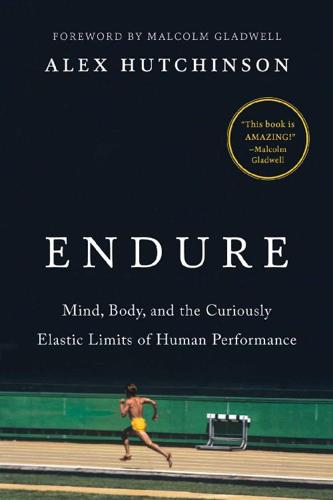
Endure: Mind, Body, and the Curiously Elastic Limits of Human Performance
by
Alex Hutchinson
Published 6 Feb 2018
Scribonius Largus, the court physician for the Roman emperor Claudius more than two thousand years ago, recommended the application of a live torpedo fish—an electric ray capable of delivering up to 200 volts at a time—to the forehead for relief of headaches, and other cultures around the world prescribed electric fish for everything from epilepsy to exorcism.2 By the end of the eighteenth century, the great debate between Luigi Galvani and Alessandro Volta had introduced the idea of “animal electricity” to the world. Galvani’s nephew Giovanni Aldini soon began using “galvanism” to treat depression in Bologna (as well as applying electricity to the brains of freshly decapitated criminals to elicit bizarre facial expressions).3 In the two centuries since then, various forms of electrical brain stimulation for mental health and other conditions have drifted in and out of fashion with decidedly mixed results.
…
A sharp bang: I wrote about Red Bull’s Project Endurance in “Your Body on Brain Doping,” Outside, August 2, 2014. 2. Scribonius Largus: C. I. Sarmiento et al., “Brief History of Transcranial Direct Current Stimulation (tDCS): From Electric Fishes to Microcontrollers,” Psychological Medicine 46, no. 3259 (2016). 3. freshly decapitated criminals: André Parent, “Giovanni Aldini: From Animal Electricity to Human Brain Stimulation,” Canadian Journal of Neurological Sciences 31 (2004): 576–84. 4. tango dancing: D. Kaski et al., “Applying Anodal tDCS During Tango Dancing in a Patient with Parkinson’s Disease,” Neuroscience Letters 568 (2014): 39–43. 5. ability to spot snipers: Vincent Clark et al., “TDCS Guided Using fMRI Significantly Accelerates Learning to Identify Concealed Objects,” NeuroImage 59, no. 1 (2012). 6.

Rage Inside the Machine: The Prejudice of Algorithms, and How to Stop the Internet Making Bigots of Us All
by
Robert Elliott Smith
Published 26 Jun 2019
They refer to the work of Italian scholar Luigi Galvani, who hung some severed frog’s legs from a brass hook and observed that on touching them with an iron scalpel they twitched. He mistakenly took this movement as a sign of some intrinsic life essence retained in the dead matter, which he called ‘animal electricity’. Of course the electricity was not in the frog’s leg but was actually due to the simple battery effect that the brass hook created when his iron scalpel touched the dead, wet appendage.4,5 These scientific theories and mistakes don’t really matter though, because like all good sci-fi the science was never the point in the story Mary created.
…
New York: Basic Books. 3Neil Stevenson, 1995, The Diamond Age: Or, a Young Lady’s Illustrated Primer. Penguin. 4Disagreements over these matters would actually prompt Galvani’s colleague, Alessandro Volta, to create the first real battery, and with it the modern idea of electricity. 5W. Bernardi, 2001, The Controversy Over Animal Electricity in 18th-Century Italy: Galvani, Volta, and Others. Revue D’histoire des Sciences, 54: 53–70, www.edumed.org.br/cursos/neurociencia/controversy-bernardi.pdf INDEX abacus, abaci, here, here, here, here ACLU, here Albright, Jonathan, here Alexa. See Amazon’s Echo AlphaGo, here, here, here Amazon, here, here, here Amazon Mechanical Turk, here Amazon’s Echo, here American Eugenics Records Office, here American Study Group, here antibodies, here, here antigens, here, here Aristotle, here, here, here, here, here Arrow, Kenneth, here associationism, here, here astragalus, astragali, here, here, here automata, here, here, here, here Aytes, Ayhan, here Babbage, Charles, here, here, here, here, here, here, here, here, here, here, here Babbage Effect, here, here, here Babbage’s Engines, here, here, here, here, here, here, here, here Bacon, Francis, here Bayes, Thomas, here Bayesian inference, here Bayesian reasoning, here, here Bayes’ rule, here Bedford College for Women, here Bell Curve, here, here, here, here, here, here, here, here, here, here, here, here Bell Laboratories, here Bernoulli, Jacob, here, here Binet, Alfred, here, here, here binomial distribution, here black swans, here, here, here Blackwell, Antoinette Brown, here Bloomfield, Leonard, here Box, George, here, here, here Brexit, here, here, here, here brittleness, here, here, here, here, here, here Bryan, William Jennings, here Bryon, Lord, here, here Buolamwini, Joy, here Burks, Arthur, here Byron, Lord, here, here, here, here Cajal, Santiago Ramon y, here Cambridge Analytica, here, here Campbell, Joseph, here Cardano, Gerolamo, here, here, here, here, here Cardwell, Chris, here Carroll, Galen, here Cattell, Raymond, here Central Limit Theorem.

Humble Pie and Cold Turkey: English Expressions and Their Origins
by
Caroline Taggart
Published 29 Sep 2021
When we talk about galvanizing someone into action – spurring them on, encouraging them to get on with something – we’re referring to the technology that inspired Mary Shelley to write Frankenstein in 1816. Luigi Galvani was an eighteenth-century Italian scientist who, probably accidentally, discovered that if you put an electric charge through the leg of a dead frog, the muscles contracted and it appeared to come back to life. His experiments on ‘animal electricity’ – electricity as an intrinsic force in living creatures, flowing through their bodies as easily as blood – gave Shelley the idea of animating what she called the Creature, now better known from film versions of her story as Frankenstein’s monster. Why Galvani’s name was also adopted for galvanization – covering iron or steel with a coating of zinc to protect rusting – is unclear, as much of the development of this process was done by a near-contemporary, Alessandro Volta, who gave his name to the early battery known as the voltaic pile, and to the volt, the SI unit of electric potential.

Humble Pie and Cold Turkey
by
Caroline Taggart
When we talk about galvanizing someone into action – spurring them on, encouraging them to get on with something – we’re referring to the technology that inspired Mary Shelley to write Frankenstein in 1816. Luigi Galvani was an eighteenth-century Italian scientist who, probably accidentally, discovered that if you put an electric charge through the leg of a dead frog, the muscles contracted and it appeared to come back to life. His experiments on ‘animal electricity’ – electricity as an intrinsic force in living creatures, flowing through their bodies as easily as blood – gave Shelley the idea of animating what she called the Creature, now better known from film versions of her story as Frankenstein’s monster. Why Galvani’s name was also adopted for galvanization – covering iron or steel with a coating of zinc to protect rusting – is unclear, as much of the development of this process was done by a near-contemporary, Alessandro Volta, who gave his name to the early battery known as the voltaic pile, and to the volt, the SI unit of electric potential.

Running on Empty: Overcome Your Childhood Emotional Neglect
by
Jonice Webb
Published 1 Oct 2012
Feeling Word List: SAD Tearful Sorrowful Pained Grief Anguish Desperate Low Pessimistic Unhappy Grieved Mournful Grave Dismayed Bummed Despondent Heavy-hearted Scorned Grey Miserable Blue Longing Disappointed Grim Gloomy Lost Moody Burdened Discouraged Let down DEPRESSED Lousy Dysphoric Dreary Dark Black Morose Dour Besieged Morbid Suicidal Accursed Abysmal Ashamed Diminished Self-destructive Self-abasing Guilty Dissatisfied Loathsome Worn out Repugnant Despicable Abominable Terrible Despairing Sulky Bad Sense of loss DAMAGED Aberrant Maimed Detestable Ruined Defiled Scarred Impure Spoiled Infected Scathed Beleaguered Impaired Disgusting Crippled Abhorred Destroyed Abnormal Contaminated Contemptible UNCOMFORTABLE Awkward Discomfit Antsy Disturbed Sickened Off-balance Sour Fidgety Peculiar Icky Ill-tempered Odd Inappropriate Out of it Conspicuous Off-center Rotten Discontented ANGRY Misanthropic Miffed Irritated Contemptuous Fiery Spiteful Perturbed Abrasive Stewing Seething Livid Confrontive Pissed off Bristling Dangerous Galled Bugged Disgruntled Contentious Abusive Enraged Surly Bloodthirsty Hostile Insulting Disgusted Exasperated Repulsed Steamed Dismayed Frustrated Revolted Troubled Cranky Horrified Furious Outraged Ticked off Riled Nauseated Vicious Wary Sore Annoyed Upset Hateful Unpleasant Offensive Bitter Aggressive Aggravated Appalled Resentful Inflamed Provoked Incensed Infuriated Cross Worked up Boiling Fuming BORED Mundane Listless Understimulated Dreary Tedious Unchallenged Bland HURTFUL Mean Enraged Rude Retaliatory Menacing Ruthless Mouthy Nasty Dangerous Vengeful Offensive Malicious Malignant Malevolent Cruel Manipulative Sadistic Harmful Controlling VULNERABLE Exposed Bullied Corralled Small Susceptible Expendable Bare Raw Delicate One-upped Weak Obscured Little Eclipsed Controlled Conned Conspicuous Sensitive Constrained Blind Bested Lost Broken One-down Open Captive EMBARRASSED Humiliated Ashamed Clumsy Uncomfortable Mortified Awkward Silly Disgraced Conspicuous Foolish Absurd GUILTY Undeserving Responsible Rueful Contrite Regretful Accountable Remorseful Culpable Deceitful Wrong At fault Faulty ALONE Abandoned Antisocial Outnumbered Loveless Estranged Bypassed Dissociated Longing Inaccessible Friendless Needy Disregarded Distant Alienated Desolate Avoided Apart Disliked Deserted Aloof Ignored Dispossessed Rejected Isolated Excluded Jilted LOST Rudderless Planless Scattered Seeking Stranded Stumped CONFUSED Ambivalent Puzzled Uncertain Conflicted Indecisive Hesitant Misgiving Lost Unsure Uneasy At a loss Tense Perplexed Flustered Confused Befuddled Disconcerted Mystified Bewildered Anxious Muddled Baffled Addled Distracted Doubtful SHOCKED Agape Aghast Agog Flabbergasted Stricken Jolted Stunned Dumbstruck Startled Jarred Astonished Rattled Dumbfounded Dazed Stupefied Dumfounded Astounded Awestruck NEGATIVE Averse Hesitant Against Opposed Quarrelsome Resistant Disharmonious Rebellious Oppositional Stubborn Recalcitrant TIRED Battle-worn Worn Overdrawn Drained Stretched Pooped Strained Faint Bedraggled Dried up Listless Limp Overloaded Harried Hassled Downtrodden Depleted Exhausted Done-in Fried Weary Finished Dispirited Spent Careworn Used up AFRAID Fear Boxed-in Cornered Chilled Suspicious Anxious Doubtful Cowardly Quaking Menaced Wary Frightened Jittery Jumpy Scared Threatened Terrified Spooked Shaken Uneasy Overwhelmed Alarmed Worried ANXIOUS Daunted Timid Knotted Self-conscious Neurotic Restless Fretful Stressed Guarded Ruffled Skittish Preoccupied Frantic Pell-mell Obsessive Shy Overcome Shaky Jangled Insecure Nervous Dreading Panicky Unnerved Cautious Antsy HURT Invalidated Chastised Invisible Ridiculed Screwed Wronged Abased Punched Humiliated Squashed Burned Blamed Annihilated Rebuffed Brutalized Bushwhacked Laughed at Agonized Heart-broken Disrespected Victimized Insulted Jilted Cheated Devalued Forgotten Intimidated Neglected Defeated Persecuted Put down Oppressed Slighted Aching Afflicted Injured Offended Rejected Assaulted Dejected Tortured Pained Deprived Tormented Bleeding Crushed Abused Damaged Ignored Snubbed Diminished Betrayed Deflated VICTIMIZED Bullied Quashed Mistreated Scapegoated Eviscerated Jinxed Hoodwinked Suffocated Intruded upon Erased Set up Objectified Railroaded Reamed Denounced Emasculated Controlled Denigrated Deceived Bamboozled Abused Crushed Duped Devoured Dumped-on Cuckolded Cursed Degraded Damned Debased Cheated Cheated on Deprived Crucified INADEQUATE Mediocre Unworthy Incompetent Spineless Insecure Meek Insufficient Powerless Helpless Inferior Incapable Useless Inept Unworthy Weak Pathetic Worthless One-down Deficient Enfeebled Second rate HELPLESS Incapable Controlled Stifled Impotent Paralyzed Straight-jacketed Stuck Stonewalled Micro-managed Lame Useless Vulnerable Hindered Immobile Ineffective Futile Forced Despairing Distressed Pathetic Dominated Tragic Woeful Frustrated Hesitant Empty Inferior Fatigued Alone Overwhelmed INDIFFERENT Apathetic Lifeless Empty Bland Robotic Dead Disinterested Emotionless Lackadaisical Banal Blasé Cavalier Cold Bored Absent Neutral Weary Reserved Nonchalant Insensitive Uncaring Dulled Mindless HAPPY Joyous Mirthful Peachy Fortunate Giddy Exuberant Buoyant Delighted Overjoyed Gleeful Thankful Festive Ecstatic Satisfied Glad Cheerful Sunny Merry Perky Jubilant Elated Delirious Soaring Important Lucky Great Sparkling Bouncy Blissful OPEN Understanding Ready Confident Reliable Kind Accepting Receptive Satisfied Sympathetic Adventurous Fun-loving Boundless Exultant Interested Free Amazed Easy Aboard ALIVE Playful Courageous Energetic Glowing Spunky Liberated Optimistic Peppy Reborn Provocative Impulsive Free Frisky Animated Electric Spirited Thrilled Wonderful Awake Colorful Glorious GOOD Serene Relaxed Deserving Calm Decent Pleasant At ease Comfortable Pleased Clean Fabulous Encouraged Surprised Extraordinary Smart Clever Content Quiet Bright Pleased Reassured Sure Certain LOVING Considerate Admiration Passionate Devoted Attracted Cuddly Tender Sensitive Caring Affectionate Love Connection Warmth INTERESTED Engrossed Snoopy Nosy Concerned Affected Intrigued Fascinated Inquisitive Rapt Absorbed Curious Attentive Aware Imaginative STRONG Hardy Tenacious Resolute Stable Authoritative Persevering Revitalized Brave Unique Dynamic Nervy Moral Influential Feisty Rebellious Outspoken Sure Ethical Certain Free Clear Graceful In control Confrontive Reliable Able Accomplished Assertive Assured Solid Capable Competent Courageous Hardy POSITIVE Enthusiastic Excited Eager Keen Earnest Intent Anxious Determined Inspired Complimented Productive Pumped Sincere Hopeful ACCEPTABLE Adequate Okay Good enough Average Functional Legitimate CARED FOR Admired Pampered Appreciated Accommodated Esteemed Honored THANKFUL Appreciative Grateful Obliged Beholden Owing SMART Heady Intelligent Bright Accurate Brainy Focused Brilliant Knowing Decisive Clear Quick Informed Observant Articulate Imaginative Logical Mature Sagacious Wise Skilled Thoughtful Sensible CARING Benevolent Loving In tune Connected Empathetic Selfless Sympathetic Gracious Dedicated Attached Loyal Generous Affectionate Responsible Warm Nurturing Cuddly Communicative RELAXED Calm Breezy Sleepy Released Chill Resolved ATTRACTIVE Captivating Pretty Funny Jazzy Irresistible Handsome Good-looking Desirable Appealing Popular Lovely Beautiful Hot Gorgeous Interesting Dandy Sexy Dapper Well-dressed Coordinated Stylish Debonair REFERENCES Ainsworth, Mary.

Factfulness: Ten Reasons We're Wrong About the World – and Why Things Are Better Than You Think
by
Hans Rosling
,
Ola Rosling
and
Anna Rosling Rönnlund
Published 2 Apr 2018
To learn more about the methodology of these polls and the supporting data behind the correct answers, see “Notes” here. Education of girls in low-income countries Majority income level Extreme poverty Lifespan Future number of children1 More people Natural disasters Where people live Vaccination of children Women’s education Endangered animals Electricity Climate Number of correct answers out of the first twelve questions NOTES We have taken enormous care to check and double-check our sources and the ways we have used them: in a book about Factfulness, we do not want to make a single fact mistake. But we are human beings; however hard we strive, we still make mistakes.

Volt Rush: The Winners and Losers in the Race to Go Green
by
Henry Sanderson
Published 12 Sep 2022
One day, instead of touching a wire to the frog’s leg, an assistant ‘gently touched the point of a scalpel to the medial crural nerves of this frog. Immediately all the muscles of the limbs contracted.’6 The experiment had shown that the legs contracted without any direct connection to the Dollond machine. Galvani continued to experiment and published a full account in 1791. Galvani still believed that he had generated ‘animal electricity’. But Alessandro Volta, a professor of physics at the University of Pavia, read Galvani’s reports and decided to replicate the experiment. He found that two different metals in contact with each other would make the frog’s legs twitch. Volta concluded that it was the contact between the two different metals that generated the electricity.

The Empathic Civilization: The Race to Global Consciousness in a World in Crisis
by
Jeremy Rifkin
Published 31 Dec 2009
In 1838, another Italian, Carlo Matteucci, a professor of physics at the University of Pisa, showed that “an electrical current accompanies each heart beat.”4 In 1843, the German physiologist Emil du Bois-Reymond was able to detect voltage potential in resting muscles.5 In this early period of electricity development, the observations of physiologists studying the electrical workings in humans and animals proved helpful to engineers constructing the first practical electrical devices. The engineers’ work, in turn, provided helpful clues to the workings of the central nervous system. For example, the nervous system provided a useful model for building the telegraph, while the electric fish gave Volta ideas about how to build a battery. Du Bois-Reymond dedicated Animal Electricity, his 1848 book on electrical excitation in nerves and muscles, to Michael Faraday, whose “descriptions of induction in electrical circuits” provided useful analogies for describing excitation of nerves.6 In a public lecture delivered in 1851, du Bois-Reymond explained how the workings of the telegraph and other new electrical technology paralleled the way animals are constructed.
…
Adler, Alfred adolescent advertising industry Affective Neuroscience (Panksepp) afferent feedback Age of Faith Age of Reason Age of Sentimentalism aggression agricultural surplus agriculture feudal hydraulic societies industrial late Middle Ages Roman Empire Sumeria Ainsworth, Mary Akhenaten Akkadians Alcoholics Anonymous aliens (the other) Allen, Myles Allen, Steve Allen, Woody altruism Amazon rain forest Ambrose of Milan American culture American Dream American Idol American Indian American Literature American Psychologist American Revolution Anderson, David Animal Electricity (du Bois-Reymond) Animal Planet animal protection animal rights movement animal species fairness and gestures and language grooming behavior learned behavior play and sense of humor sensory apparatus of social nature Annan, Kofi anomie anosognosia anterior cingulate cortex anthrax anxious attachment Aquinas, Thomas, Saint Arbib, Michael archaic man Archer, Brian architecture Arecibo Observatory (Puerto Rico) Aristotle Armstrong, Karen Armstrong, Nancy Arsenio, William F.
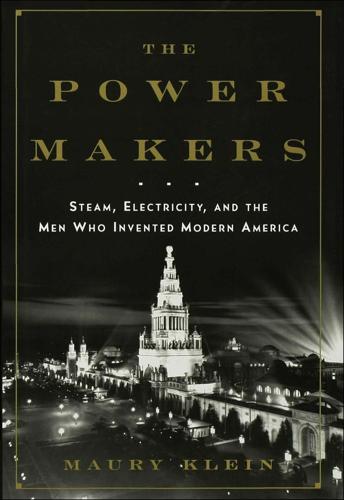
The Power Makers
by
Maury Klein
Published 26 May 2008
Every source of electric current remained transitory, produced by friction, heat, or induction from the release of accumulated charges in a Leyden jar. Little progress could be made unless some more continuous source of electricity was found. The long and winding road of discovery in this area began with Alessandro Volta, an unassuming physics professor who had been drawn to some experiments with animal electricity conducted by another professor, Luigi Galvani.26 During his research with frogs, Galvani had in 1780 stumbled onto an astonishing discovery: A dead frog’s leg convulsed when touched with a metal scalpel. This accidental observation lured Galvani into eleven years of research into the phenomenon before he published his findings.
…
The first device to replenish an electrical charge through induction rather than friction, it became enormously popular. Volta became professor of physics at the University of Padua at thirty-seven, traveled widely, learned several languages, and won election to the Royal Society of London in 1791, the same year Galvani published his paper. By late 1793 Volta had rejected Galvani’s claim of “animal electricity,” believing that the source of electricity lay rather in the contact of two dissimilar metals during the experiment. Using one of his own inventions, the condensing electroscope, Volta systematically tested a variety of metal disks for their “electromotive force,” a term applied to electric current as opposed to static electricity.27 By measuring the amount of charge on each disk, Volta found that contact between zinc and copper left the latter with a positive charge and the former with a negative one.

Trick or Treatment: The Undeniable Facts About Alternative Medicine
by
Edzard Ernst
and
Simon Singh
Published 17 Aug 2008
These tractors, as he dubbed them, were not inserted into the patient, but were merely brushed over the painful area for several minutes, during which time they would ‘draw off the noxious electrical fluid that lay at the root of suffering’. Luigi Galvani had recently shown that the nerves of living organisms responded to ‘animal electricity’, so Perkins’ tractors were part of a growing fad for healthcare based on the principles of electricity. As well as providing electrotherapeutic cures for all sorts of pains, Perkins claimed that his tractors could also deal with rheumatism, gout, numbness and muscle weakness. He soon boasted of 5,000 satisfied patients and his reputation was buoyed by the support of several medical schools and high-profile figures such as George Washington, who had himself invested in a pair of tractors.

In Our Own Image: Savior or Destroyer? The History and Future of Artificial Intelligence
by
George Zarkadakis
Published 7 Mar 2016
He luckily survived the electric shock because he was standing under an umbrella to keep dry! A few years later, in 1791, the Italian physician Luigi Galvani (1737–1798) conducted a series of experiments with frogs or, to be more precise, with frog’s legs. The experiments showed that when electricity passed through a dead frog’s legs they kicked. Galvani coined the term ‘animal electricity’. He had discovered bioelectricity. Galvani’s experiments were repeated by Alessandro Volta (1745–1827) – who later invented the electrical battery – and ignited the imagination of Europe. By the mid-nineteenth century, Emil du Bois-Reymond (1818– 1896), a German physician, had developed the galvanometer to measure electric currents in animals, frogs and humans.

The Forever War
by
Dexter Filkins
Published 15 Sep 2008
“I keep my enemies guessing,” he said, brightening again. As Qaisi and I talked, a group of four Iraqi men sat down at a plastic table next to ours. One of them I recognized immediately: Hadi al-Amari, the head of the Badr Brigade, the very militia Qaisi believed had murdered his brother. Suddenly I felt an animal electricity in the air. Qaisi and Amari were eyeing each other. Qaisi stood up; so did Amari. I wondered if they were armed. “My friend,” Qaisi said, “it is so good to see you.” “Yes, it has been a long time,” Amari said. The two men embraced and kissed each other on their bearded cheeks. “We really must get together,” Amari said.

Out of Africa
by
Karen Blixen
Published 1 Jan 1937
I often had bad burns to treat, for the Kikuyu at night sleep round the fires in their huts, and the piles of burning wood or charcoal may collapse and slide down on them, — when at times I had run out of my store of medicine, I found that honey was not a bad ointment for burns. The atmosphere of the terrace was animated, electric, like the atmosphere of the Casinos in Europe. The low lively flow of talk would stop when I came out, but the silence was pregnant with possibilities, now the moment had come when anything might happen. They did however always wait for me myself to choose my first patient. I knew very little of doctoring, just what you learn at a first aid course.
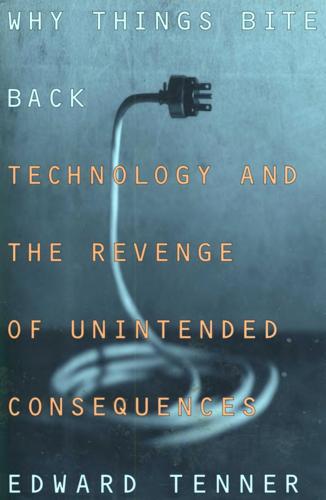
Why Things Bite Back: Technology and the Revenge of Unintended Consequences
by
Edward Tenner
Published 1 Sep 1997
But his project was a scientific and technological experiment, and he had left his studies at the University of Ingolstadt after a successful career in which he "had made some discoveries in the improvement of chemical instruments, which procured me great esteem and admiration in the university." He was a genteel amateur in the eighteenth-century mode, created just before the rise of nineteenth-century academic and industrial science. Mary Shelley based her story on actual "galvanic" experiments wherein corpses were animated electrically. Was she warning against the conquest of nature by science, against male appropriation of life-giving power? A growing number of critics think so, perhaps reading certain twentieth-century attitudes into Shelley's story. Victor Frankenstein was reassembling and reviving life, not growing it.

The One Device: The Secret History of the iPhone
by
Brian Merchant
Published 19 Jun 2017
The first true battery was invented by the Italian scientist Alessandro Volta in 1799 in an effort to prove that his colleague Luigi Galvani had been wrong about frog power. Galvani had run currents of electricity through dead frogs’ nervous systems—the series of experiments that would inspire Mary Shelley’s Frankenstein—and had come to believe the amphibians had an internal store of “animal electricity.” He’d noticed that when he dissected a leg that was hung on a brass hook with an iron scalpel, it tended to twitch. Volta thought that his friend’s experiments were actually demonstrating the presence of an electrical charge running through the two different metal instruments via a moist intermediary.

Open Standards and the Digital Age: History, Ideology, and Networks (Cambridge Studies in the Emergence of Global Enterprise)
by
Andrew L. Russell
Published 27 Apr 2014
Louis, leading figures in electrical science, including the British inventor and engineer Colonel R. E. B. Crompton, Swedish Nobel Prize winner Svante Arrhenius, Lord Kelvin, and the American inventor Elihu Thomson, created the International Electrotechnical Commission (IEC). Their goal was to establish a representative body that could bring the “cooperative spirit that animates electrical workers” into a formal and permanent organization.34 As the IEC grew and matured in the early twentieth century, electrical scientists understood perfectly well that standards were not exclusively technical matters but rather technically oriented instances of diplomacy, with a heavy dose of international prestige and commercial power on the line.35 Taken together, the wide variety of standards developed for and inspired by electrical telegraphy illustrate the fundamental irony of standardization in the late nineteenth century: there was no standard way to make standards.

Fantasyland: How America Went Haywire: A 500-Year History
by
Kurt Andersen
Published 4 Sep 2017
The New York Times assumed his and his followers’ insanity: 16 OF DIVINE’S CULT SHOW MENTAL ILLS, one article was headlined; ONLY 2 OUT OF 18 OBSERVED AT BELLEVUE FOUND FREE OF WELL-DEFINED PSYCHOSES. McPherson, known as Sister Aimee, was a faith-healing, tongues-speaking Pentecostal divorcée preaching in a five-thousand-seat church in L.A. with a giant animated-electric-light billboard inside. After she went missing for five weeks in 1926, claiming she’d been kidnapped, Time described “her ‘disappearance,’ ” the way it referred to Billy Sunday’s “sermons,” with disparaging quotation marks. The bestselling novel of 1927 was Sinclair Lewis’s Elmer Gantry, a satire about a Billy Sunday–esque evangelist and his McPhersonian lover.
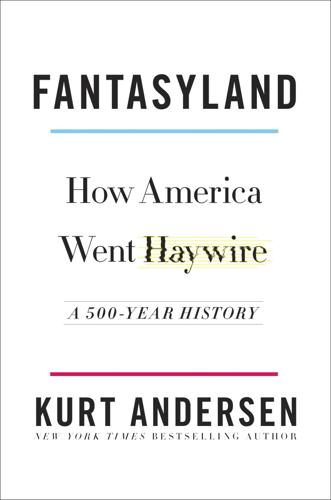
Fantasyland
by
Kurt Andersen
Published 5 Sep 2017
The New York Times assumed his and his followers’ insanity: 16 OF DIVINE’S CULT SHOW MENTAL ILLS, one article was headlined; ONLY 2 OUT OF 18 OBSERVED AT BELLEVUE FOUND FREE OF WELL-DEFINED PSYCHOSES. McPherson, known as Sister Aimee, was a faith-healing, tongues-speaking Pentecostal divorcée preaching in a five-thousand-seat church in L.A. with a giant animated-electric-light billboard inside. After she went missing for five weeks in 1926, claiming she’d been kidnapped, Time described “her ‘disappearance,’ ” the way it referred to Billy Sunday’s “sermons,” with disparaging quotation marks. The bestselling novel of 1927 was Sinclair Lewis’s Elmer Gantry, a satire about a Billy Sunday–esque evangelist and his McPhersonian lover.

NeuroTribes: The Legacy of Autism and the Future of Neurodiversity
by
Steve Silberman
Published 24 Aug 2015
Even when subjected to decibel levels capable of causing physical damage to the eardrum, Mike and Marty “remained unperturbed, particularly after the first two or three presentations.” Lovaas doubled down, turning to a method of punishment that had a long track record in behaviorist experiments on animals: electric shock. To head off any criticism for employing such harsh methods on preschool-age children, he added, “It is important to note, in view of the moral and ethical reasons which might preclude the use of electric shock, that their future was certain institutionalization.” He taped strips of metal foil to the floor of a room in his lab and wired these strips to a respectable-sounding device called a Harvard Inductorium—a modified Faraday coil that offered fine-tuning of its electrical output down to zero.

Energy and Civilization: A History
by
Vaclav Smil
Published 11 May 2017
Electricity A systematic understanding of the fundamental properties and laws of electricity was gained through the labors of many European and American scientists and engineers during the latter part of the eighteenth century and the first six decades of the nineteenth century, and in many cases their pioneering contributions were acknowledged by using their surnames for basic physical units. Famous eighteenth-century milestones included Luigi Galvani’s (1737–1798) experiments with frog legs during the 1790s (and hence his mistaken notion of “animal electricity”), Charles Augustin Coulomb’s (1736–1806) studies of electric force (the coulomb is now the standard unit of electric charge), and Alessandro Volta’s (1745–1827) construction of the first electric battery (the volt is the unit of electric potential). In 1819 Hans Christian Ørsted (1777–1851) uncovered the magnetic effect of electrical currents (the orsted is now a unit of magnetic field), and during the 1820s André-Marie Ampère (1775–1836) formulated the concept of a complete circuit and quantified the magnetic effects of electric current (the ampere is the unit of electric current).